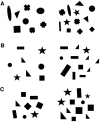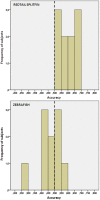Inter-specific differences in numerical abilities among teleost fish
- PMID: 23162517
- PMCID: PMC3498878
- DOI: 10.3389/fpsyg.2012.00483
Inter-specific differences in numerical abilities among teleost fish
Abstract
Adults, infants and non-human primates are thought to possess similar non-verbal numerical systems, but there is considerable debate regarding whether all vertebrates share the same numerical abilities. Despite an abundance of studies, cross-species comparison remains difficult because the methodology employed and the context of species examination vary considerably across studies. To fill this gap, we used the same procedure, stimuli, and numerical contrasts to compare quantity abilities of five teleost fish: redtail splitfin, guppies, zebrafish, Siamese fighting fish, and angelfish. Subjects were trained to discriminate between two sets of geometrical figures using a food reward. Fish initially were trained on an easy numerical ratio (5 vs. 10 and 6 vs. 12). Once they reached the learning criterion, they were subjected to non-reinforced probe trials in which the set size was constant but numerical ratios varied (8 vs. 12 and 9 vs. 12). They also were subjected to probe trials in which the ratio was constant, but the total set size was increased (25 vs. 50) or decreased (2 vs. 4). Overall, fish generalized to numerosities with a 0.67 ratio, but failed with a 0.75 ratio; they generalized to a smaller set size, but not to a larger one. Only minor differences were observed among the five species. However, in one species, zebrafish, the proportion of individuals reaching the learning criterion was much smaller than in the others. In a control experiment, zebrafish showed a similar lower performance in shape discrimination, suggesting that the observed difference resulted from the zebrafish's difficulty in learning this procedure rather than from a cross-species variation in the numerical domain.
Keywords: Betta splendens; Danio rerio; Fish cognition; Poecilia reticulata; Pterophyllum scalare; Xenotoca eiseni.
Figures





Similar articles
-
Zebrafish excel in number discrimination under an operant conditioning paradigm.Anim Cogn. 2022 Aug;25(4):917-933. doi: 10.1007/s10071-022-01602-y. Epub 2022 Feb 18. Anim Cogn. 2022. PMID: 35179665 Free PMC article.
-
Perception of the Müller-Lyer illusion in guppies.Curr Zool. 2020 Apr;66(2):205-213. doi: 10.1093/cz/zoz041. Epub 2019 Sep 3. Curr Zool. 2020. PMID: 32440279 Free PMC article.
-
Do humans (Homo sapiens) and fish (Pterophyllum scalare) make similar numerosity judgments?J Comp Psychol. 2016 Nov;130(4):380-390. doi: 10.1037/com0000045. Epub 2016 Oct 13. J Comp Psychol. 2016. PMID: 27736107
-
Numerical abilities in fish: A methodological review.Behav Processes. 2017 Aug;141(Pt 2):161-171. doi: 10.1016/j.beproc.2017.02.001. Epub 2017 Feb 3. Behav Processes. 2017. PMID: 28167200 Review.
-
Spontaneous versus trained numerical abilities. A comparison between the two main tools to study numerical competence in non-human animals.J Neurosci Methods. 2014 Aug 30;234:82-91. doi: 10.1016/j.jneumeth.2014.04.027. Epub 2014 May 2. J Neurosci Methods. 2014. PMID: 24793399 Review.
Cited by
-
The role of body surface area in quantity discrimination in angelfish (Pterophyllum scalare).PLoS One. 2013 Dec 27;8(12):e83880. doi: 10.1371/journal.pone.0083880. eCollection 2013. PLoS One. 2013. PMID: 24386299 Free PMC article.
-
Searching for the Critical p of Macphail's Null Hypothesis: The Contribution of Numerical Abilities of Fish.Front Psychol. 2020 Jan 31;11:55. doi: 10.3389/fpsyg.2020.00055. eCollection 2020. Front Psychol. 2020. PMID: 32116895 Free PMC article. Review.
-
The role of item size on choosing contrasted food quantities in angelfish (Pterophyllum scalare).Sci Rep. 2019 Oct 25;9(1):15305. doi: 10.1038/s41598-019-51753-1. Sci Rep. 2019. PMID: 31653899 Free PMC article.
-
Cichlids and stingrays can add and subtract 'one' in the number space from one to five.Sci Rep. 2022 Mar 31;12(1):3894. doi: 10.1038/s41598-022-07552-2. Sci Rep. 2022. PMID: 35361791 Free PMC article.
-
Non-numerical strategies used by bees to solve numerical cognition tasks.Proc Biol Sci. 2021 Feb 24;288(1945):20202711. doi: 10.1098/rspb.2020.2711. Epub 2021 Feb 17. Proc Biol Sci. 2021. PMID: 33593192 Free PMC article.
References
-
- Agrillo C., Dadda M. (2007). Discrimination of the larger shoal in the poeciliid fish Girardinus falcatus. Ethol. Ecol. Evol. 19, 145–15710.1080/08927014.2007.9522574 - DOI
LinkOut - more resources
Full Text Sources
Miscellaneous

